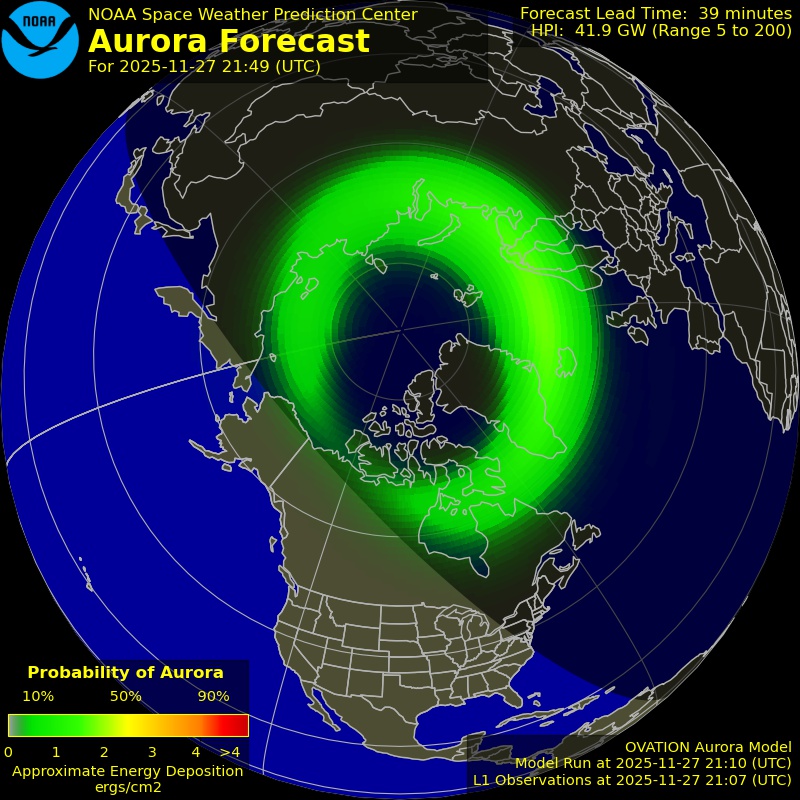Northern Lights Forecast for Grand Rapids
Substorm
Substorm Phase: Quiet; Aurora Activity Score: 15/100
Ideal Conditions for Northern Lights in Grand Rapids
Power: +22 Gw | Bz: -2 | Wind Speed: 450+ | Density: 4+ | Kp: 2+
Auroras have been known to show in Grand Rapids with lesser data.
Don’t Miss the Magic!
Stay ahead of the Northern Lights with real-time alerts. Subscribe now to receive a text or call whenever the aurora is active—so you never miss a moment of the show.
How to use this data:
If you're thrilled to witness the captivating Northern Lights in Grand Rapids, our tool serves as a valuable resource for predicting aurora appearances. We collect live satellite data and present it in a user-friendly dashboard, carefully filtering out unnecessary information. Though deciphering the data may seem complex, our comprehensive guide ensures a seamless grasp.
Maximizing the Forecast:
Enhance your Aurora-chasing adventure by utilizing our extended forecast feature tailored for Grand Rapids. With this tool, you can plan your outings well in advance, granting you ample time to prepare for the mesmerizing Northern Lights spectacle. But that's not all – we take it a step further by providing real-time minute-to-minute insights for the day of to better plan your trip, offering an immersive and personalized experience that elevates your exploration of the Grand Rapids night sky.
Where are the Best Places to See the Northern Lights in Grand Rapids?
Here are the best places to view the Aurora Borealis in Grand Rapids, Manitoba:
- Lake Winnipeg Shores:The shores of Lake Winnipeg offer unobstructed views of the night sky, making it an ideal spot for witnessing the Aurora Borealis. The tranquil setting and dark surroundings enhance the aurora viewing experience.
- Countryside Surroundings: Venture into the countryside around Grand Rapids for optimal aurora sightings. Away from urban light pollution, the open fields and quiet environment create a perfect backdrop for the dancing lights of the Northern Lights.
- Clearwater Lake Provincial Park: Clearwater Lake Provincial Park is known for its pristine and serene setting, making it a popular destination for stargazers and aurora enthusiasts. The park's dark skies provide an excellent canvas for experiencing the mesmerizing Aurora Borealis.
- Hiking Trails and Lookouts: Explore local hiking trails and elevated viewpoints for elevated vantage points to observe the Northern Lights. These spots not only offer stunning natural landscapes but also a chance to capture the captivating auroras against the backdrop of the night sky.
- Cabin Getaways: Consider booking a cabin or lodge in the Grand Rapids area, where you can enjoy the comforts of a cozy retreat while still having access to clear night skies. Cabins away from the city lights offer a unique opportunity to witness the auroras in a peaceful setting.
Remember that for the best aurora experience, it's important to choose locations with minimal light pollution and to check real-time aurora forecasts for increased chances of sightings.
When Can You See the Northern Lights in Grand Rapids?
To optimize your chances of witnessing this captivating phenomenon in Grand Rapids, plan your Aurora-chasing excursions on clear nights, far from city lights. While the auroras can manifest after sunset, the optimal viewing hours generally extend from around 11:00 PM to 3:00 AM. However, during nights of intensified auroral activity, the Northern Lights may grace the sky earlier, casting an extraordinary spectacle across the Grand Rapids nightscape.
What is the Best Time of Year for Aurora Borealis viewing in Grand Rapids?
The best time of year for Aurora Borealis viewing in Grand Rapids is during the fall, winter, and early spring months. These seasons offer longer periods of darkness, creating optimal conditions for observing the captivating display of the Northern Lights. While the Aurora Borealis can potentially be seen throughout the year, the increased darkness during these colder months enhances the visibility and provides a higher likelihood of experiencing this natural phenomenon in all its splendor.
Can You See the Northern Lights in Grand Rapids Tonight?
To determine if the Northern Lights are visible in Grand Rapids, MB tonight, it's important to stay updated with real-time aurora forecasts and monitor the current geomagnetic conditions. Our Aurora Admin tool provides the latest information, and while the data is valuable, remember that aurora visibility can be influenced by various factors beyond numerical predictions.
How long do the Northern Lights usually last?
The duration of the Northern Lights, also known as the Aurora Borealis, can vary widely. On average, a single display of the Northern Lights may last anywhere from a few minutes to around half an hour. However, during periods of heightened solar activity and favorable conditions, the auroras can persist for several hours, providing a more extended and captivating spectacle. The exact duration depends on factors such as the intensity of the solar storm, atmospheric conditions, and the strength of the aurora display. In Grand Rapids, Manitoba, the Northern Lights can sometimes offer longer periods of viewing due to the area's favorable conditions for auroral displays.
What to Expect?
While viewing the captivating Northern Lights in Grand Rapids, prepare to be captivated by an array of colors gracefully dancing across the night sky. While photographs often depict vibrant shades of green, pink, and purple, remember that the naked eye might observe a more delicate display. Expect to witness beautiful white flashes or flickering, akin to cloud formations. Thanks to Winnipeg's lower hemispheric power values, you'll likely predominantly see enchanting greens and reds illuminating the night canvas. To enjoy a more vibrant and enchanting view, consider capturing long-exposure photographs to reveal the true brilliance of the auroras. However, keep in mind that the colors you perceive with your eyes may not perfectly mirror the vivid tones captured in photographs. The mesmerizing dance of the Northern Lights offers a unique and awe-inspiring spectacle that promises an unforgettable experience, regardless of the specific colors you observe.
Aurora Oval
Northern Hemisphere

